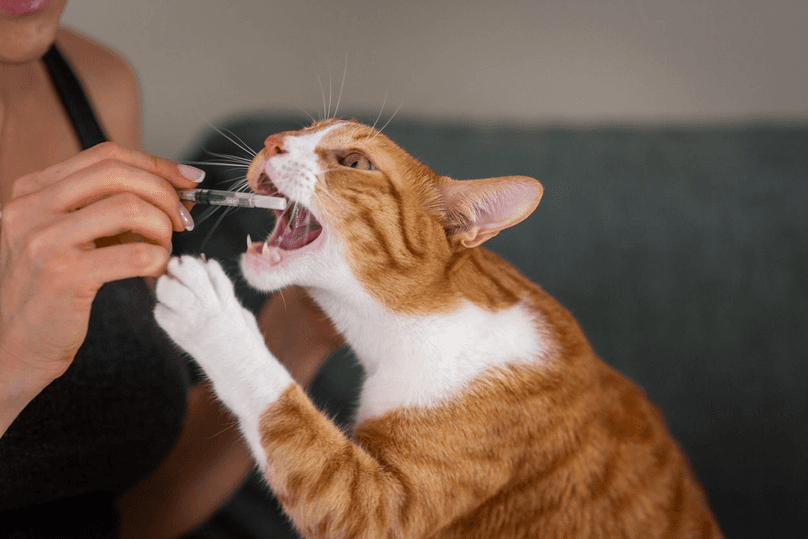
Administering Liquid Medicine
It’s nerve-racking when your furry friend falls ill, whether it be an infection or inflammation, and nursing them back to health shouldn’t add to the stress. When the veterinarian recommends liquid medication as a treatment, it can be challenging to establish a regular routine. Here are tips on how to give a cat liquid medicine safely, while avoiding its bite.
It can be tough to administer medications—from dewormers to antibiotics, meloxicam, and gabapentin— as cats are notorious for refusing to take them. No matter how feisty your cat may be, however, they still need to get better. If you are struggling to give your cat liquid medication, there are few tips and tricks to try out.
Struggling to Give Your Difficult Cat Liquid Medicine?
Every cat owner knows how hard it can be to give your cat medicine, especially when they are being defensive. Fortunately, with some training, it doesn’t always have to be stressful and time consuming —and your furry friend will get back on the road to recovery.
There are a number of ways to make the medication process simpler, but here are a few of our favorites:
Disguising Medication by Adding it to a Meal.If you are unsure how to give a cat liquid medicine, one of the best ways to start is by combining the prescribed medication and your cat’s favorite meal. For some cats, hiding the liquid medication in a small amount of wet food will do the trick. Pick a food your cat likes, feed them when they are hungry, and only offer a small portion so they are sure to finish it. Prior to trying this approach, it’s best to check-in with your veterinarian first to ask if this combination is appropriate.
Injecting Medication with a Syringe.If the first method doesn’t work, you could try injecting medication into your cat’s mouth with the syringe, but this can be the most challenging method.
- Start by swaddling your cat in a towel and placing them on your lap.
- Slide the syringe in through the corner of your cat’s mouth. Be sure the syringe is up by the cheek, as opposed to the back of the throat, so you can ensure it is swallowed completely.
- Plunge the syringe slowly—the cat may need time to swallow and breathe.
- Reward your furry friend with a treat! Over time, they will form a positive association with the activity and it will be easier to treat them.
As an owner, it’s important to only administer medicines prescribed by a veterinarian and to treat your cat for the entire duration prescribed. Most cat liquid medication already comes with a syringe to administer the appropriate amount, but if it isn’t currently measured, be sure to have the prescribed amount drawn up and prepared by your veterinarian.
Editor’s Note:Helpful Vancouver Vet offers this Youtube video on giving a cat liquid medicine.
What to Do When Your Cat Resists Medication
Adding medication to food does not always work—and is not always recommended. If you have a cat that’s ill, your feline may face a lack of appetite, and adding medication could even create a food aversion. If you have multiple cats and put your medication into the food without careful monitoring, you risk accidentally dosing the wrong cat. Additionally, there’s a chance your cat may not finish it at all and won’t receive a full dose.
If you are administering the liquid medication directly, having one person hold your cat’s body and one person deliver the medication can make a world of a difference. You could also try alternative positions, like gently holding your cat by the scruff of its neck, allowing its paws to lift from your lap. This should allow the mouth to open slightly. If you remain calm, this may also help calm them down.
Learn When To Consult a Veterinarian
Most cats will spit out some of their medication. It’s a best practice to not re-medicate them unless you are sure none of the medication was taken. If all else fails, check to see if your medication is available in alternate forms with a veterinarian, like a chewable pill or treat. Some medications are not available in alternate forms, however, and when that is the case you should bring your cat into the veterinarian’s office for medicating and consult them for your options. A veterinary technician may also be able to visit your home. If your cat begins to eat more poorly because of medication, however, there may be a larger problem at hand to address.
This is when visiting your veterinarian and having the pet insurance becomes important. Regular health checkups will only become increasingly important as your cat grows older.
Continue to Provide the Medication, As Long As it is Prescribed
While your cat may be resistant, it is important to continue to provide them with the medication for as long as it is prescribed, when you find the opportunity to. You need not medicate them at the same time of day, or in the same location—if your cat sees you approaching with medication, you may face additional delays. While it may take time, extra planning, and a little ingenuity, with consistent treatment your furry friend will be on to their next adventure.